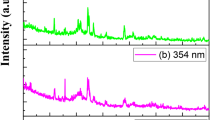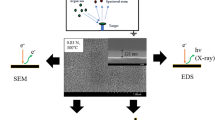Abstract
In this paper, undoped and tin-doped ZnO nanostructures were grown onto non-conductive substrates by a simple solution method. Structural, morphological, optical and electrical properties of the structures were investigated with respect to tin concentration. From XRD studies, all the ZnO nanostructures were found as hexagonal wurtzite type structures growing preponderantly oriented with c-axis normal to the substrate. An increase in tin content resulted in a decrease in grain size, whereas the dislocation density increases. SEM observations indicated that all the structures were textured throughout the substrates without any cracks or pores. The influence of incorporation of tin on surface morphology of the samples was clearly seen. Average diameter of the nanostructures decreased with increasing tin content. Absorption spectra of the structures revealed that the band gap of the films increases with increasing tin concentration. It is found that the tin-doped samples have higher average transmittance than the undoped one. The 1 % tin-doped sample exhibited ∼80 % average transparency, which was the best transparency among the doped samples. Electrical measurements showed that resistivity of the structures increased with increasing dopant concentration. This increasing was attributed due to a decrease in carrier concentration caused by carrier traps at the grain boundaries.






Similar content being viewed by others
References
M. Tadatsugu, Transparent conducting oxide semiconductors for transparent electrodes. Semicond. Sci. Technol. 20, 35 (2005)
Y. Yan, L. Zhou, J. Zou, Y. Zang, Appl. Phys. A, Mater. Sci. Process. 94, 559 (2009)
F. Bayansal, S. Kahraman, G. Çankaya, H.A. Çetinkara, H.S. Güder, H.M. Çakmak, Growth of homogenous CuO nano-structured thin films by a simple solution method. J. Alloys Compd. 509, 2094 (2011)
W. Bai, K. Yu, Q. Zhang, Y. Huang, Q. Wang, Z. Zhu, N. Dai, Y. Sun, Chemical solution-process method to synthesize ZnO nanorods with ultra-thin pinheads and ultra-thin nanobelts. Appl. Phys. A, Mater. Sci. Process. 87, 755 (2007)
B. Ergin, E. Ketenci, F. Atay, Characterization of ZnO films obtained by ultrasonic spray pyrolisis technique. Int. J. Hydrog. Energy 34, 5249 (2009)
F. Favier, E.C. Walter, M.P. Zach, T. Benter, R.M. Penner, Hydrogen sensors and switches from electrodeposited palladium nanowires. Science 293, 2227 (2001)
M. Seol, H. Kim, W. Kim, K. Yong, Highly efficient photoelectrochemical hydrogen generation using a ZnO nanowire array and a CdSe/CdS co-sensitizer. Electrochem. Commun. 12, 1416 (2010)
N.H. Al-Hardan, M.J. Abdullah, A. Abdul Aziz, Sensing mechanism of hydrogen gas sensor based on RF-sputtered ZnO thin films. Int. J. Hydrog. Energy 35, 4428 (2010)
S.T. Shishiyanu, T.S. Shishiyanu, O.I. Lupan, Sensing characteristics of tin-doped ZnO thin films as NO2 gas sensor. Sens. Actuators B 107, 379 (2005)
J.H. Lee, B.O. Park, Transparent conducting ZnO:Al, In and Sn thin films deposited by the sol–gel method. Thin Solid Films 426, 94 (2003)
F. Paraguay, D.M. Miki-Yoshida, J. Morales, J. Solis, W.L. Estrada, Influence of Al, In, Cu, Fe and Sn dopants on the response of thin film ZnO gas sensor to ethanol vapor. Thin Solid Films 373, 137 (2000)
C.Y. Tsay, H.C. Cheng, Y.T. Tung, W.H. Tuan, C.K. Lin, Effects of Sn-doped on microstructural and optical properties of ZnO thin films deposited by sol–gel method. Thin Solid Films 517, 1032 (2008)
M. Fragala, Y. Aleeva, G. Malandrino, ZnO nanorod arrays fabrication via chemical bath deposition: ligand concentration effect study. Superlattices Microstruct. 48, 408 (2010)
F. Bayansal, H.A. Çetinkara, S. Kahraman, H.M. Çakmak, H.S. Güder, Nano-structured CuO films prepared by simple solution methods: plate-like, needle-like and network-like architectures. Ceram. Int. 38, 1859 (2012). doi:10.1016/j.ceramint.2011.10.011
Z.Q. Xu, H. Deng, Y. Li, Q.H. Guo, Y.R. Li, Characteristics of Al-doped c-axis orientation ZnO thin films prepared by the sol–gel method. Mater. Res. Bull. 41, 354 (2006)
R.J. Hong, K. Helming, X. Jiang, B. Szyszka, Texture analysis of Al-doped ZnO thin films prepared by in-line reactive MF magnetron sputtering. Appl. Surf. Sci. 226, 378 (2004)
H. Deng, J.J. Russell, R.N. Lamb, B. Jiang, Y. Li, X.Y. Zhou, Microstructure control of ZnO thin films prepared by single source chemical vapor deposition. Thin Solid Films 458, 43 (2004)
V. Pecharsky, P. Zavalij, Fundamentals of Powder Diffraction and Structural Characterization of Materials (Springer, New York, 2005)
A. Van Der Drift, Evolutionary selection, a principle governing growth orientation in vapour-deposited layers. Philips Res. Rep. 22, 267 (1967)
A.A. Dakhel, F.Z. Henari, Optical characterization of thermally evaporated thin CdO films. Cryst. Res. Technol. 38, 979 (2003)
S.H. Jeong, B.N. Park, S.B. Lee, J.H. Boo, Metal-doped ZnO thin films, synthesis and characterizations. Surf. Coat. Technol. 201, 5318 (2007)
G.B. Williamson, R.C. Smallman, III. Dislocation densities in some annealed and cold-worked metals from measurements on the X-ray debye-scherrer spectrum. Philos. Mag. 1, 34 (1956)
S. Ilıcan, M. Çağlar, Y. Çağlar, Sn doping effects on the electro-optical properties of sol–gel derived transparent ZnO films. Appl. Surf. Sci. 256, 7204 (2010)
C.M. Muiva, T.S. Sathiaraj, K. Maabong, Effects of doping concentration on properties of aluminium doped zinc oxide thin films prepared by sprey pyrolysis for transparent electrode applications. Ceram. Int. 37, 555 (2011)
M.L. de la Olvera, A. Maldonado, R. Asomoza, M. Melendez-Lira, Effect of the substrate temperature and acidity of the spray solution on the physical properties of F-doped ZnO thin films deposited by chemical spray. Sol. Energy Mater. Sol. Cells 71, 61 (2002)
V.R. Shinde, C.D. Lokhande, R.S. Mane, S. Han, Hydrophobic and textured ZnO films deposited by chemical bath deposition: annealing effect. Appl. Surf. Sci. 245, 407 (2005)
G. Hodes, A.A. Yaro, F. Decker, P. Motisuke, Three-dimensional quantum-size effect in chemically deposited cadmium selenide films. Phys. Rev. B 36, 4215 (1987)
S.M. Sze, Semiconductor Devices, Physics and Technology (Wiley, New York, 1985)
R. Dalven, Introduction to Applied Solid State Physics (Plenum Press, New York, 1990)
U. Ozgur, Y.I. Alivov, C. Liu, A. Teke, M.A. Reshchikov, S. Dogan, V. Avrutin, S.J. Cho, H. Morkoc, J. Appl. Phys. 98, 041301 (2005)
A.E. Jimenez-Gonzalez, J.A. Soto Urueta, R. Suarez-Parra, Optical and electrical characteristics of aluminum-doped ZnO thin films prepared by solgel technique. J. Cryst. Growth 192, 430 (1998)
S. Major, A. Banerjee, K.L. Chopra, Thickness-dependent properties of indium-doped ZnO films. J. Mater. Res. 1, 300 (1986)
J.W. Orton, M.J. Powell, The hall effect in polycrystalline and powdered semiconductors. Rep. Prog. Phys. 43, 1263 (1980)
E. Hahn, Some electrical properties of zinc oxide semiconductor. J. Appl. Phys. 22, 855 (1951)
J. Lee, J.H. Hwang, J. Mashek, T. Mason, A. Miller, R. Siegel, Impedance spectroscopy of grain boundaries in nanophase ZnO. J. Mater. Res. 10, 2295 (1995)
V.R. Shinde, T.P. Gujar, C.D. Lokhande, R.S. Mane, S.H. Han, Mn doped and undoped ZnO films: a comparative structural, optical and electrical properties study. Mater. Chem. Phys. 96, 326 (2006)
Acknowledgements
This work was supported by the Scientific Research Commission of Mustafa Kemal University (Project No. 1102 M 0101).
Author information
Authors and Affiliations
Corresponding author
Rights and permissions
About this article
Cite this article
Kahraman, S., Bayansal, F., Çakmak, H.M. et al. Synthesis and characterization of undoped and tin-doped ZnO nanostructures. Appl. Phys. A 109, 87–93 (2012). https://doi.org/10.1007/s00339-012-7093-1
Received:
Accepted:
Published:
Issue Date:
DOI: https://doi.org/10.1007/s00339-012-7093-1




